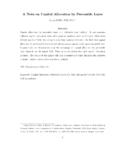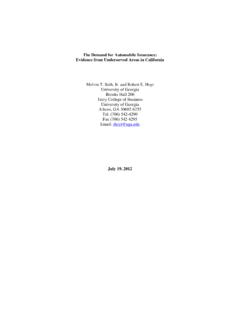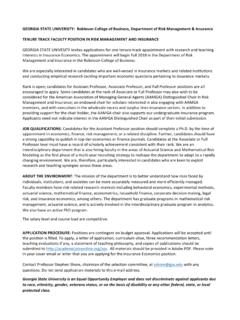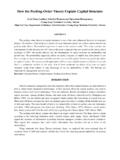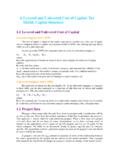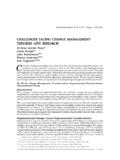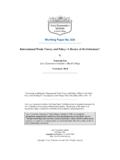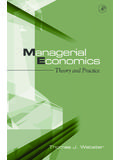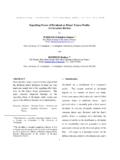Transcription of Economic Capital for Insurers: Insurance Cycle and ...
1 1 Economic Capital for Insurers: Insurance Cycle and catastrophic Risk ABSTRACT This paper proposes a stochastic model to study the Economic Capital and performance of an insurer of natural disasters in the presence of underwriting Cycle . The model included a parameter capturing the strategy adopted by the insurer under different cycles. We use the ruin probability and the conditional value-at-risk adjusted returns to capture the performance of the insurer . Using historical natural catastrophic events data of the United States from 1960 to 2008, we find different behaviours depending on the type of catastrophic event. The existence of underwriting Cycle represents a major risk for the insurer , but it can be advantageous if the insurer chooses the right strategy at the onset.
2 Furthermore, we show that catastrophic Insurance portfolio needs to be composed of at least 50 elements to gain from diversification. Keywords: Economic Capital , Insurance Cycle , catastrophic risk. JEL Codes: VERY PRELIMINARY, PLEASE DO NOT QUOTE WITHOUT THE AUTHORS PERMISSION 2 I. Introduction The regulatory framework Solvency II s objective is to better align Insurance and reinsurance companies regulatory Capital with their risk posture. It is then important for insurers and reinsurers to have a better understanding of the risks underlying their activities in order to optimally allocate Capital among their business activities. There is therefore a need for the development of sound internal models to estimate insurers obligations.
3 The technical specification of the Quantitative Impact Studies 4 (QIS4, see CEIOPS (2007)) defines the underwriting risk as the risk related to Insurance contracts. This concerns uncertainties associated to the technical results of the insurer . Unfortunately, the QIS4 does not require any supplementary Capital for underwriting Cycle . Underwriting (or Insurance ) Cycle can generate artificial volatility for the technical results beyond the statistically determined Insurance risk ( , Meyers (2007)). Therefore, Insurance Cycle should be accounted for when developing internal models under Solvency II regulation since the additional volatility caused by it can lead to a larger Capital level than what is actually required. The objective of this paper is to evaluate the Economic Capital for casualty and property insurers by accounting for underwriting Cycle and catastrophic risk.
4 More specifically, the paper addresses the following research questions: (1) How to model an insurer s risks when facing Insurance Cycle ? (2) What is the impact of Insurance Cycle on the Economic Capital and performance of an insurer in the case of catastrophic risks? (3) What is the effect of portfolio diversification in the case of natural catastrophic risk? To respond to the above research questions, we present a stochastic model which account for the effect of underwriting cycles. In the proposed model, the insurer can adjust its security loading with regards to Insurance Cycle and its business strategy to remain competitive. The insurer can also adjust its claims rate to reflect its overall exposure for a given business strategy. Note however that our aim is not to study the causes of the underwriting Cycle ; we instead analyze the behaviour of the insurer when the Cycle occurs.
5 We use the probability of ruin and the conditional value-at-risk (VaR)- adjusted returns to capture the performance of the insurer . We use historical natural catastrophic events data of the United States from 1960 to 2008 for the empirical analyses. The application of our model to the four catastrophic events considered (earthquake, hurricane, tornado and flood) show different patterns depending on the type of event. The existence 3 of underwriting Cycle represents a major risk for the insurer , but it can be advantageous if the insurer chooses the right strategy at the onset. Furthermore, our analyses show that disaster risk portfolio needs to be composed of at least 50 elements to obtain the diversification benefit. The rest of the paper is structured as follows.
6 Section 2 presents the literature review on underwriting cycles: existing theories and different approaches to model underwriting cycles. Section 3 presents our model with the dynamics of the insurer s assets and liabilities and the Insurance Cycle . Section 4 presents the Economic Capital calculation and the solvability and performance measures of the insurer . Section 5 presents results for natural disaster ( catastrophic ) risks, the impact of Insurance Cycle in the case of catastrophic risk using Monte Carlo simulations and the effect of diversification on the overall portfolio risk. Section 6 concludes. II. Literature review on Insurance Cycle : theories and models Insurance Cycle theories Insurance Cycle or underwriting Cycle refers to periods of positive and negative returns in Insurance business over time.
7 As pointed out by Stewart (1981), competition among insurers will generally determine the Insurance premium proposed by insurers, because it is relatively easy for new comers to enter the Insurance business and there is no patent for Insurance products. Therefore, in the Insurance industry, almost all insurers offer more or less the same products. The only way for one company to differentiate itself from the competition is to propose the same service at the most competitive price (low price) possible. Stewart (1981) defined Insurance Cycle as the seasonal fluctuation of Insurance premiums and profits over time. Generally speaking, Insurance Cycle can either be soft market or hard market . Hard market is characterised by reduced supply of Insurance products, lower loss coverage and higher premiums.
8 Unlike the hard market, soft market corresponds to abundant supply of Insurance products, larger loss coverage and lower 1 For instance, a Cycle may start when insurers impose restrictive underwriting criteria and increase their premiums following a period of severe losses. These restrictive criteria and the increase in premiums are more likely to generate more profits in the business, and thus will attract more new Capital investments in the industry (entry of new actors) and lead to an increase in the underwriting capacity (supply). However, since the goal of an insurer is to underwrite the maximum number of contracts at a high profitability level, it is more likely that, in a competitive environment, the premium will tend to decrease and the underwriting criteria will become less restrictive in order to obtain new market shares.
9 Profits will then decrease with more generous promises for claims coverage. The insurer will then increase its premium rates and a new Cycle will begin again. 4 Although most industries are exposed to boom and bust cycles, cycles are particularly critical in the Insurance business because they are unpredictable. Insurance cycles affect all areas of the Insurance business, except the life Insurance segment. However, the intensity and duration of the Cycle may vary from one business segment to another. Cummins and Outreville (1987) argued that Insurance cycles observed in the US and other developed countries are more likely to exist in other parts of the world because of the development of reinsurance business around the world. Over the past recent years, many attempts have been made to identify and quantify Insurance Cycle with some times very limited dataset, and up to now, no model has proven to perform better than others.
10 The literature has provided many theoretical arguments to explain Insurance cycles. There is no common agreement on the causes of Insurance cycles. For instance, Fung et al. (1998) tested statistically all the available theories and found that no theory actually can explain fully the whole Insurance Cycle . Three main theories seem to prevail: (1) disequilibrium between supply and demand ( , Berger (1988), Cummins and Danzon (1997), Feldblum (2001), Froot and O Connell (1997), Gron (1994), Harrington and Danzon (1994), Niehaus and Terry (1993), Outreville (1981), Venezian (1985), Winter (1991, 1994)); (2) external shocks, such as interest rate changes or institutional factors or catastrophic events ( , Chen et al. (1999), Cummins et al.)
